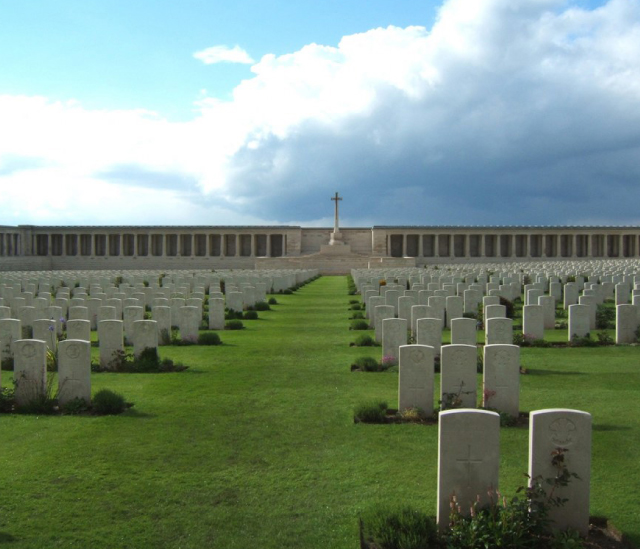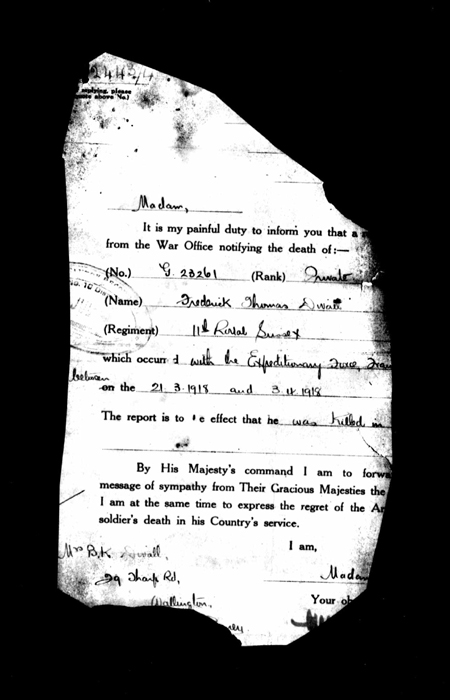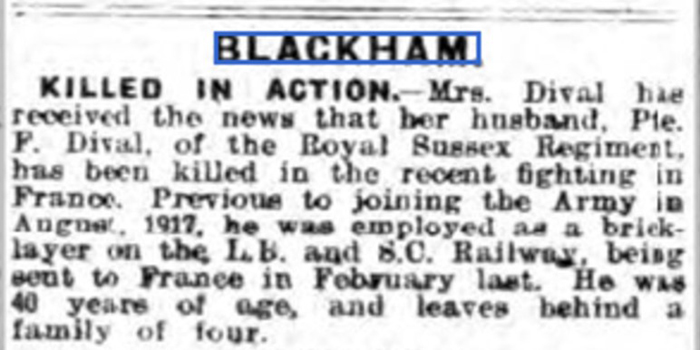Frederick Thomas Divall, was born and raised in Blackham Village. The town still commemorates his name and sacrifice during the First World War.
Frederick was born in 1878 in Blackham, the son of Jesse and Sarah. In 1891 the family lived at Highfields Park Cottage. In 1901, aged 23, he lived at Gonore working as a bricklayer for the London Brighton and South Coast Railway (LBSC). He married Bertha Kate Sales, daughter of Joseph and Elizabeth Sales. Both born in Blackham, perhaps Fred and Bertha were childhood sweethearts. They married in Surrey in 1905 and in 1911 they lived at 29 Tharp Road, Wallington, Surrey with their children, Frederick (b1906), Bertha Kate (1908) and Doris Emma (1911). Daughter Ivy followed in 1912.
As a skilled worker for the railways, Fred was protected from enlistment until late in the war when manpower was depleted and older, married men were called upon. He joined the Royal Sussex Regiment on 21st August 1917 and arrived in France 4th February 1918 and posted to the 11th Battalion.
The Bolshevik Revolution of 1917 took Russia out of the war. This released several divisions of German troops for redeployment on the western front. Operation Michael (the Kaiserschlacht) or the 1918 Spring Offensive was the final roll of the dice for Germany. The aim was to punch through the British lines, turn right and capture the Channel ports before the Americans arrived in force. Other forces would capture Paris, war over.
On 21st March 1918 the Germans attacked. Despite intelligence reports about troop build ups, the British seemed unprepared. The retreat from this onslaught was chaotic but still a disciplined, fighting withdrawal, much to the credit of the British forces. Fred’s death is recorded as between 21st March and 3rd April 1918. On 5th April, when the roll was called, the 11th had lost 20 officers and 300 other ranks, killed, missing or taken prisoner.
Bertha was overwhelmed with grief by her husband’s death. A snippet of the surviving records describes her as depressed and anxious. Her mother, Elizabeth Sales, took control and handled the bureaucracy regarding the welfare of the children. On 3rd June 1918, aged 38, Bertha Kate Divall died of an asthma attack, no doubt stress induced.
The children, orphaned within two months, now returned to the village. To its credit, the bureaucracy moved fast, letters and certificates were forwarded to government departments marked “very urgent”. An allowance of 37/6d (1.75 pounds) a week was granted to Elizabeth as guardian of the children.
Elizabeth, widowed in 1896 and at the age of 68, needed every ounce of strength as this was the worst year of her life. In July 1917 her son Amos was killed in fighting near Ypres. At the same time as the above tragedy, the death of another of her sons, Frederick Nelson, aged 41, is recorded at Hailsham. Her grandson, Ernest Harding, was hospitalised with the Spanish flu when it was killing more young men than the guns. The only bright moment would be the marriage of her youngest daughter Laura (Bessie) to Herbert French while on leave from his service with the Cheshire Regiment in the 3rd Qtr 1918.
Without local knowledge, or the 1921 census, we cannot know who cared for the children. I suspect it was Bessie and Herbert French. The Blackham school photos show Bertha Kate Jnr in 1922 and Ivy in 1920.
Elizabeth died in the 2nd Qtr 1921, aged 71, shortly before the unveiling of the Lychgate memorial.
Frederick Thomas Divall is commemorated on the memorial gate at Blackham Village. His name appears on the Pozieres Memorial in France.
This story was contributed by Frank Wiltshire, researcher for Blackham at War.










